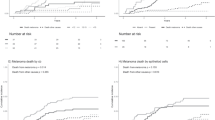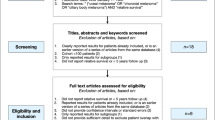Abstract
Purpose
Treatment of uveal melanoma can impair patients’ psychological well-being. We evaluated patient-reported outcome measures (PROMs) of anxiety, depression, and quality of life (QoL) over 2 years following treatment in a consecutive sample of uveal melanoma patients, compared observations to population normative values and examined whether outcomes differed according to patients’ age, gender, and whether or not they were treated by enucleation or had a poor prognosis (presence of monosomy 3).
Design
Prospective longitudinal study.
Participants
Patients (N=411) with uveal melanoma treated between 2008 and 2011.
Methods
Self-report questionnaire study. We compared mean PROMs scores obtained 6 months, 1 year, and 2 years after treatment to published population normative values using 2-sample t-tests, and tested the association of these scores with gender, age, treatment by enucleation, and monosomy 3 using mixed-model ANOVAs.
Results
On QoL and depression, patients were similar to or better than normative values at all time points, but there was some evidence that females were more anxious than female normative values (Ps<0.001–<0.05). Younger patients (P<0.01) and female patients (P<0.01) were the most anxious overall. Enucleation was not associated with PROMs. Patients with monosomy 3 showed more depressed mood at all the three time points (P<0.05).
Conclusions
Patients treated for uveal melanoma can expect, within 6 months of treatment, to have a QoL that is similar to that of the general population. Younger female patients and patients with monosomy 3 are more likely to be distressed, and clinicians will need to be alert to this.
Similar content being viewed by others
Log in or create a free account to read this content
Gain free access to this article, as well as selected content from this journal and more on nature.com
or
References
Singh AD, Turell ME, Topham AK . Uveal melanoma: trends in incidence, treatment, and survival. Ophthalmology 2011; 118: 1881–1885.
Kujala E, Mäkitie T, Kivelä T . Very long-term prognosis of patients with malignant uveal melanoma. Invest Ophthalmol Vis Sci 2003; 44: 4651–4659.
Augsburger JJ, Corrêa ZM, Shaikh AH . Effectiveness of treatments for metastatic uveal melanoma. Am J Ophthalmol 2009; 148: 119–127.
Hope-Stone L, Brown SL, Heimann H, Damato B, Salmon P . How do patients with uveal melanoma experience and manage uncertainty? A qualitative study. Psycho-Oncology 2015; 24: 1485–1491.
Brandberg Y, Kock E, Oskar K, Trampe E, Seregard S . Psychological reactions and quality of life in patients with posterior uveal melanoma treated with ruthenium plaque therapy or enucleation: a one year follow-up study. Eye 2000; 14: 839–846.
Chabert S, Velikay-Parel M, Zehetmayer M . Influence of uveal melanoma therapy on patients’ quality of life: a psychological study. Acta Ophthalmol Scand 2004; 82: 25–31.
Collaborative Ocular Melanoma Study-Quality of Life Study Group. Quality of Life after iodine 125 brachytherapy vs enucleation for choroidal melanoma: 5-year results from the collaborative ocular melanoma study: COMS QOLS report no. 3. Arch Ophthalmol 2006; 124: 226–238.
Cruickshanks KJ, Fryback DG, Nondahl DM, Robinson N, Keesey U, Dalton DS et al. Treatment choice and quality of life in patients with choroidal melanoma. Arch Ophthalmol 1999; 117: 461–467.
Reimer J, Esser J, Fleiss A, Hessel A, Anastassiou G, Krausz M et al. Quality of life in patients with malignant choroidal melanoma after radiotherapy. Graefes Arch Clin Exp Ophthalmol 2003; 241: 371–377.
Reimer J, Voigtlaender-Fleiss A, Karow A, Bornfeld N, Esser J, Helga Franke G . The impact of diagnosis and plaque radiotherapy treatment of malignant choroidal melanoma on patients’ quality of life. Psycho-Oncology 2006; 15: 1077–1085.
Amaro TAC, Yazigi L, Erwenne C . Depression and quality of life during treatment of ocular bulb removal in individuals with uveal melanoma. Eur J Cancer Care (Engl) 2010; 19: 476–481.
Wiley JF, Laird K, Beran T, McCannel TA, Stanton AL . Quality of life and cancer-related needs in patients with choroidal melanoma. Br J Ophthalmol 2013; 97: 1471–1474.
Linden W, Vodermaier A, MacKenzie R, Grieg D . Anxiety and depression after cancer diagnosis: Prevalence rates by cancer type, gender and age. J Affect Disorders 2012; 141: 343–351.
Beran TM, McCannel TA, Stanton AL, Straatsma BR, Burgess BL . Reactions to and desire for prognostic testing in choroidal melanoma patients. J Genet Couns 2009; 18: 265–274.
Sheilds CL, Shields JA, Singh AD, Santos MC, Carvalho C . Combination of clinical factors predictive of growth of small choroidal melanocytic tumors. Arch Ophthalmol 2000; 118: 360–364.
Sen J, Groenewald C, Hiscott PS, Smith PA, Damato BE . Transretinal choroidal tumor biopsy with 25-gauge vitrector. Ophthalmology 2006; 113: 1028–1031.
Damato B, Heimann H . Personalized treatment of uveal melanoma. Eye 2013; 27: 172–179.
Damato B, Eleuteri A, Taktak AFG, Coupland SE . Estimating prognosis for survival after treatment of choroidal melanoma. Prog Retin Eye Res 2011; 30: 285–295.
Zigmond AS, Snaith RP . The hospital anxiety and depression scale. Acta Psychiatr Scand 1983; 67: 361–370.
Cella DF, Tulsky DS, Gray G, Sarafian B, Linn E, Bonomi A et al. The functional assessment of cancer therapy scale: development and validation of the general measure. J Clin Oncol 1993; 11: 570–579.
Webster K, Yost K . The functional assessment of chronic illness therapy (FACIT) measurement system: properties, applications and interpretations. Health Qual Life Outcomes 2003; 1: 79–86.
Hinz A, Brähler E . Normative values for the hospital anxiety and depression scale (HADS) in the general German population. J Psychosom Res 2011; 71: 74–78.
Lisspers J, Nygren A, Soderman E . Hospital anxiety and depression scale (HAD): some psychometric data for a Swedish sample. Acta Psychiatr Scand 1997; 96: 281–286.
Spinhoven P, Ormel J, Sloekers PP, Kempen GI, Speckens AE, Van Hemert AM . A validation study of the hospital anxiety and depression scale (HADS) in different groups of Dutch subjects. Psychol Med 1997; 27: 363–370.
Cella DF . Manual of the Functional Assessment of Chronic Illness Therapy (FACIT Scales) (Version 4.1). Center on Outcomes Research and Education, North Western Health Care: Evanston, IL, 2004.
Janda M, DiSipio T, Hurst C, Cella DF, Newman B . The Queensland cancer risk study: general population norms for the functional assessment of cancer therapy-general (FACT-G). Psycho-Oncology 2009; 18: 606–614.
Holzner B, Kemmler G, Cella DF, De Paoli C, Meraner V, Kopp M et al. Normative data for functional assessment of cancer therapy—general scale and its use for the interpretation of quality of life scores in cancer survivors. Acta Oncol 2004; 43: 153–160.
Holladay JT . Visual acuity measurements. J Cataract Refract Surg 2004; 30: 287–290.
Vodermaier A, Millman R . Accuracy of the hospital anxiety and depression scale as a screening tool in cancer patients: a systematic review and meta-analysis. Support Care Cancer 2011; 19: 1899–1908.
Affleck G, Tennen H . Construing benefits from adversity: adaptional significance and dispositional underpinnings. J Pers 1996; 64: 899–922.
Helgeson VS, Reynolds KA, Tomich PL . A meta-analytic review of benefit finding and growth. J Consult Clin Psychol 2006; 74: 797–816.
Osbourne R, Elsworth GR, Sprangers MAG, Ort FJ, Hopper JL . The value of the hospital anxiety and depression scale (HADS) for comparing women with early onset breast cancer with population-based reference women. Qual Life Res 2004; 13: 191–206.
Herce Lopez J, Rollon Mayordomo A, Lozano Rosado R, Salazar Fernandez CI, Gallana S . Quality of life in long-term oral cancer survivors: a comparison with Spanish general population norms. J Oral Maxillofac Surg 2009; 67: 1607–1614.
Author information
Authors and Affiliations
Corresponding author
Ethics declarations
Competing interests
The authors declare no conflict of interest.
Rights and permissions
About this article
Cite this article
Hope-Stone, L., Brown, S., Heimann, H. et al. Two-year patient-reported outcomes following treatment of uveal melanoma. Eye 30, 1598–1605 (2016). https://doi.org/10.1038/eye.2016.188
Received:
Accepted:
Published:
Issue date:
DOI: https://doi.org/10.1038/eye.2016.188
This article is cited by
-
Quality of life among people with eye cancer: a systematic review from 2012 to 2022
Health and Quality of Life Outcomes (2024)
-
Predictors of emotional distress in uveal melanoma survivors: a systematic review
Eye (2023)
-
Fear of prognosis? How anxiety, coping, and expected burden impact the decision to have cytogenetic assessment in uveal melanoma patients
Supportive Care in Cancer (2022)
-
Quality of life and treatment-related burden during ocular proton therapy: a prospective trial of 131 patients with uveal melanoma
Radiation Oncology (2021)
-
A prospective study of cancer-related benefit finding in uveal melanoma patients
Journal of Behavioral Medicine (2021)



